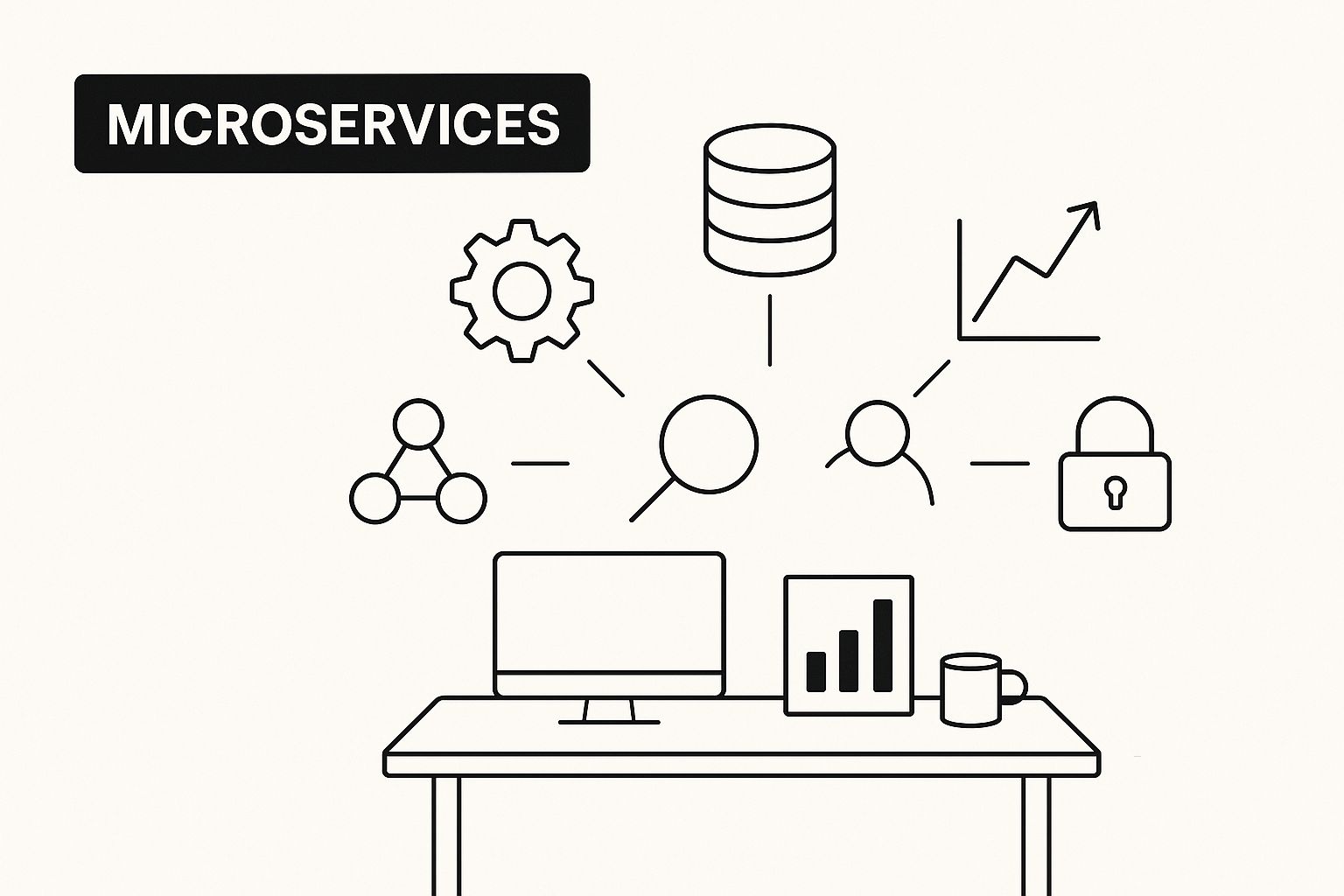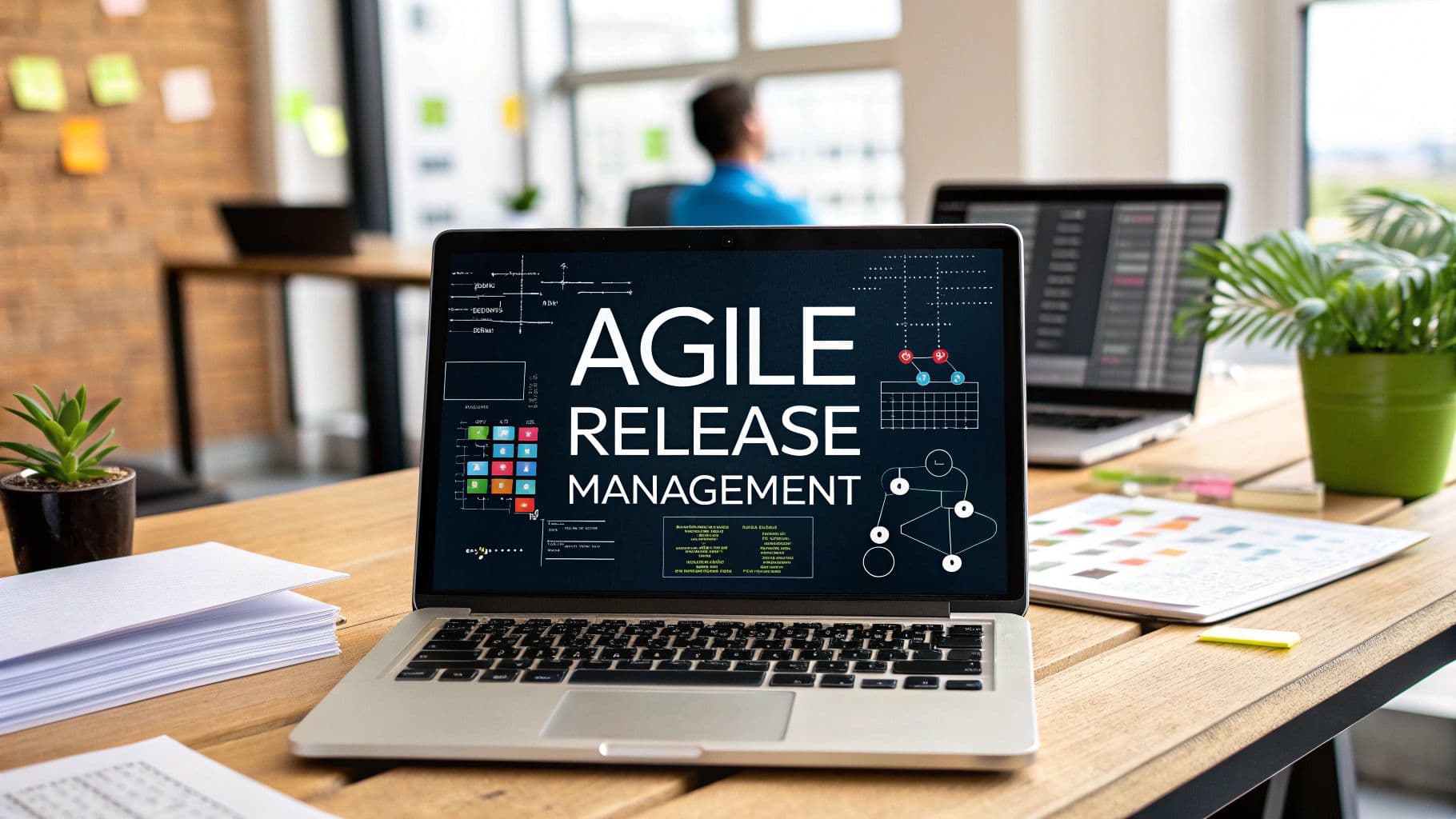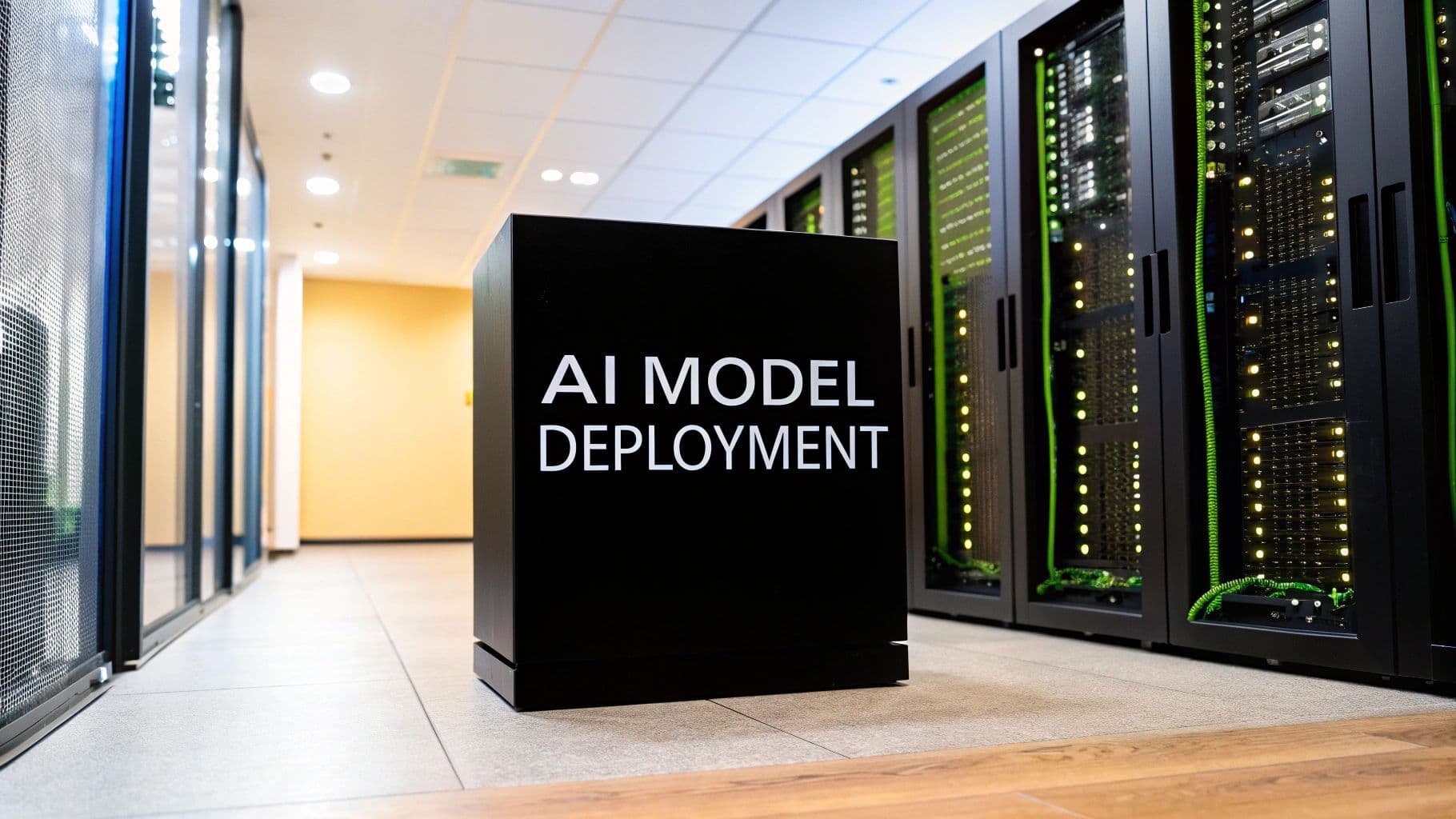scalable software architecture
microservices architecture
system scalability
architecture patterns
distributed systems
Scalable Software Architecture: Build Systems That Grow
What Scalable Architecture Actually Means In Practice
"Scalable software architecture." It's a phrase that gets thrown around a lot, but what happens when your user base suddenly takes off? I've seen firsthand how systems that looked perfect on paper buckled under the pressure of unexpected traffic, like a Black Friday stampede or a viral feature launch. The difference between success and failure often comes down to practical choices, not just fancy diagrams.
Talking to engineers who've been through these scaling battles has been enlightening. It's less about abstract principles and more about the on-the-ground decisions that keep your application running when things get chaotic. For example, a common pitfall is neglecting database optimization early on. Even the most elegant microservice architecture won’t help if your database becomes a choke point.
Identifying The Real Scalability Bottlenecks
Another common mistake is overlooking the subtle warning signs of a struggling architecture. Many teams obsess over obvious metrics like server CPU usage but miss critical indicators like database query latency or inter-service communication delays. These seemingly minor issues can snowball into major outages under pressure. Understanding how all the pieces of your system interact is paramount.
And speaking of interconnectedness, high-growth startups have faced some serious scaling challenges in recent years. I remember one client whose user base grew by a staggering 400% in just a single quarter. Their monolithic architecture nearly imploded. System response times went from milliseconds to seconds, leading to user complaints and transaction failures during peak hours. This isn't uncommon. Statistics show that 78% of rapidly growing startups identify architecture limitations as their biggest technical hurdle (McKinsey Digital Survey, 2024). Want to learn more about scalable architecture patterns? Check out this helpful resource: Scalable Architecture Patterns.
Key Metrics To Watch
So, how do you spot these hidden dangers before they wreck your system? Focus on the metrics that truly reflect user experience and system health. The table below provides a quick comparison of healthy metrics versus warning signs that you need to take action.
Let's talk about metrics. It's easy to get lost in the data, but some numbers are more important than others. The following table highlights some key areas to watch and what to look for.
| Metric | Warning Sign | Healthy Range | Action Required |
|---|---|---|---|
| Database Query Latency | Consistently above 50ms | Under 20ms | Optimize queries, add indexes, consider caching |
| Inter-Service Communication | Frequent timeouts or delays exceeding 100ms | Under 50ms | Review network configuration, optimize communication protocols |
| Error Rates | Steadily increasing, exceeding 1% | Below 0.1% | Investigate root causes, improve error handling |
| User Response Times | Consistently above 2 seconds | Under 1 second | Optimize code, improve caching, scale resources |
Building a truly scalable system requires a proactive, almost obsessive, approach to monitoring and optimization. It’s about anticipating problems before they become emergencies and having the tools and processes in place to address them quickly. Think of it as preventative maintenance for your software. It might seem like extra work upfront, but it’s a lot less painful than dealing with a complete system meltdown.
Learning From Architecture Transformations That Worked
Building scalable software architecture isn't about chasing some perfect theoretical model. It's about adapting and evolving your systems as your needs change. Some of the most valuable lessons I’ve picked up have come from watching companies rebuild their systems under intense pressure. Let’s dive into a few examples.

The Netflix Transformation: From DVDs to Streaming Dominance
Netflix’s journey from DVD-by-mail to streaming behemoth is a classic example of architectural evolution. Their initial monolithic architecture worked perfectly well for managing DVD shipments. However, as they shifted to streaming, that same architecture became a bottleneck. Suddenly, they were dealing with massive concurrent streams and the challenge of delivering a seamless experience to a global audience.
Their solution? A gutsy move to a microservices architecture. This meant breaking down their system into smaller, independent services, each owning a specific function. This allowed them to scale individual services on demand, deploy updates more quickly, and boost the overall resilience of their system. It wasn’t easy, but it was essential for their survival.
Amazon's Early Scalability Advantage
Amazon’s early architectural choices were instrumental in their ability to handle enormous scale while competitors faltered. Right from the outset, they focused on a service-oriented architecture, even before the term "microservices" became common. This forward-thinking approach enabled them to create a system that could adapt to rapidly shifting demands and explosive growth. They were also early adopters of containerization technology like Docker, which made it much easier to deploy and scale applications efficiently across their massive infrastructure. This early adoption gave them a significant edge in the intensely competitive e-commerce world.
It's worth mentioning the huge impact of the shift from monoliths to microservices on scalable software architecture. This transition really gained momentum in the early 2000s as companies like Amazon and Netflix wrestled with the limitations of their monolithic codebases. Deconstructing applications into smaller, self-contained services, each with its own database, was a game-changer. It unlocked faster updates and significantly improved scalability. The emergence of container technology further accelerated this shift. Want to explore this further? Check out this piece on the evolution of software architecture: Software Architecture Evolution.
Applying Lessons Learned to Your Own Projects
These stories aren't just interesting history. They contain practical lessons you can use in your own work. One key takeaway is the importance of anticipating future needs. Don't design solely for your current scale. Think about how your architecture will perform with 10x growth, or even 100x.
Another vital lesson is the benefit of iterative evolution. Resist the urge to rip and replace your whole system. Begin with small, incremental changes, test rigorously, and gradually move toward a more scalable architecture. Tools like AnotherWrapper can be invaluable during these transitions, offering pre-built components and services that speed up development and minimize the risk of expensive errors. It’s like a fast track to a more robust and scalable system. Using pre-built components frees you to concentrate on the architecture and how your components interact, rather than getting bogged down in the implementation details of each individual component. This focus is critical for building software that meets both today's and tomorrow’s needs. With tools like AnotherWrapper, you can be much better prepared for future architectural changes.
Choosing Architecture Patterns That Match Your Reality

The infographic above gives you a simplified view of a microservices architecture, showing how these independent services all connect. Notice the modularity and flexibility—you can scale specific components independently. This granular control is a huge advantage when dealing with fluctuating workloads and resource demands.
Picking the right architecture pattern is foundational, just like choosing the right foundation for a house. A weak foundation will crumble under pressure, but a solid one can handle future additions. I've sadly witnessed teams waste months, even years, chasing the latest architectural fads without thinking about their actual needs. Building scalable software architecture isn't about hype; it’s about finding what truly works for your project.
Event-Driven Architectures: Decoupling for Scalability
Event-driven architectures offer a powerful way to build scalable systems. Components communicate asynchronously through events, rather than direct service-to-service calls. This decoupling makes it easier to scale individual services, handle traffic spikes smoothly, and introduce new features without disrupting existing ones. Think of it as a sophisticated pub-sub system: services publish events, and others subscribe to only the events they need. The challenge lies in managing the complexity of these event flows and maintaining data consistency. AnotherWrapper can help simplify this with its pre-built event handling mechanisms and event stream monitoring tools.
CQRS: Optimizing for Reads and Writes
Command Query Responsibility Segregation (CQRS) separates read and write operations into different models. This lets you optimize each path individually, boosting performance, especially for read-heavy applications. Picture a popular e-commerce site with millions of product views every second. CQRS lets you scale the read side independently of the write side, guaranteeing quick browsing even during peak buying periods. Be aware, though, CQRS adds complexity, especially when synchronizing data between the read and write models. So, choose it strategically.
Service Mesh: Managing Microservices Complexity
As your microservices architecture expands, managing inter-service communication can become a real headache. A service mesh provides a dedicated infrastructure layer to handle this communication, as well as security and observability. It’s like having a smart traffic management system for your microservices, directing traffic, enforcing security policies, and providing insightful monitoring data. Be mindful, implementing and managing a service mesh introduces another layer of complexity. It’s a good option when your microservices architecture gets sufficiently complex, but it’s not a universal solution.
Before we dive deeper into specific patterns, let's compare them side-by-side. The following table provides a quick overview of their complexity, scalability benefits, ideal use cases, and potential pitfalls.
Architecture Pattern Comparison Guide
| Pattern | Complexity Level | Scalability Rating | Best For | Avoid When |
|---|---|---|---|---|
| Event-Driven Architecture | Medium | High | Systems with asynchronous workflows, high throughput needs | Situations requiring strict transactional consistency |
| CQRS | High | High | Read-heavy applications, complex domain models | Simple applications, limited development resources |
| Service Mesh | High | High | Large, complex microservices deployments | Smaller microservices deployments, limited infrastructure expertise |
As you can see, each pattern offers unique benefits and drawbacks. Carefully consider your project's specific requirements before making a decision.
Choosing What Works For Your Context
Software architecture has constantly evolved. From the early days of assembly language in the 1950s to object-oriented programming in the 1960s, and then microkernel architectures and event-driven programming in the 1970s, the field has adapted to the increasing demands of complex software systems. Learn more about this fascinating evolution: Software Architecture: A Journey Through Time. Building scalable software architecture is an ongoing journey, not a destination. The best pattern for your system depends on your particular needs, your team’s skills, and your business context. Don’t hesitate to experiment, learn from your mistakes, and adjust as your system grows.
Infrastructure Choices That Enable Real Scalability
You’ve designed a flawless, scalable software architecture. Fantastic! But it's all for nothing if your infrastructure buckles under pressure. I've been there, seen that – a sudden surge in traffic, and the whole system collapses. Ouch. So, let's dive into infrastructure choices that actually make a difference for scalability, not just the theoretical stuff, but what I've learned works in the real world.
Database Scaling: Beyond the Basics
Database scaling is typically the first bottleneck you encounter. Just throwing more RAM at your database server isn't going to cut it when you're dealing with huge amounts of data and tons of concurrent users. Sharding, where you distribute your database across multiple servers, is a powerful technique. Each server handles a slice of the data. It’s powerful, but managing data consistency and transactions gets more complex. From my experience, using a consistent hashing algorithm for sharding can really smooth out data distribution and lessen the impact of adding or removing shards.
Also, read replicas can be a lifesaver. They take the load off your primary database server by handling read traffic, which is a major performance booster for read-heavy applications. I once worked on a project where implementing read replicas cut our database load by a whopping 60%. The improvement in user response times was obvious.
Load Balancing: Preventing Bottlenecks
Think of load balancing as a traffic cop for your application, directing incoming requests across multiple servers. But even load balancers can become bottlenecks themselves if you're not careful. Picking the right load balancing algorithm is key. Round-robin is easy to implement, but it can lead to uneven distribution if your servers have different capacities. Least connections, on the other hand, directs traffic to the server with the fewest active connections, a much better approach when dealing with varying server loads.
Caching Strategies for Real Performance Gains
Caching is a performance game-changer, but it’s not a magic wand. You have to choose the right caching strategy and the right location for your cache. CDN caching excels at handling static content, things like images and videos, reducing latency for users around the globe. Server-side caching can store frequently accessed data, cutting down on database calls. And client-side caching can further reduce server load, but you need to manage it carefully to keep your data consistent.
This screenshot from AWS highlights the Well-Architected Framework, a set of best practices for designing and operating reliable, secure, efficient, and cost-effective cloud systems.  The key takeaway? Scalability is just one piece of the puzzle. You also need to think about security, performance, cost, and operational excellence to build a truly robust system. AnotherWrapper offers built-in integrations with various caching solutions, simplifying the implementation of effective caching strategies. And its built-in authentication features can streamline user management, saving you the hassle of building custom login systems.
The key takeaway? Scalability is just one piece of the puzzle. You also need to think about security, performance, cost, and operational excellence to build a truly robust system. AnotherWrapper offers built-in integrations with various caching solutions, simplifying the implementation of effective caching strategies. And its built-in authentication features can streamline user management, saving you the hassle of building custom login systems.
Cloud-Native vs. Hybrid: Choosing Your Path
Deciding between a cloud-native and a hybrid infrastructure is a big one. Cloud-native gives you scalability and flexibility, while hybrid solutions offer more control and can mesh with existing on-premise systems. There's no one-size-fits-all answer; it all depends on your particular needs. In my experience, cloud-native solutions are often the best fit for applications that are growing quickly because they let you scale rapidly and easily without massive upfront investment. Ultimately, building a scalable system means carefully considering all these factors.
Building Scalable Systems With Today's Tools
Everyone loves talking about scalable software architecture, but actually building it? That's where things get tricky. Let's ditch the theoretical deep dives and focus on the tools and tech that work in the real world. Forget the shiny new toys, we're talking production-ready solutions.
Leveraging Container Orchestration Effectively
You'll hear a lot about container orchestration (think Kubernetes), and it is essential for managing complex deployments. But I’ve seen teams get bogged down in overly complex Kubernetes setups for apps that really didn't need all the bells and whistles. Honestly, sometimes it feels like reinventing the wheel.
Start simple. Nail down your deployment, service, and ingress configurations. Automate your deployments and rollbacks. That alone will simplify your workflow dramatically. Tools like AnotherWrapper can make this even smoother, with pre-built configurations that streamline the integration with container orchestration platforms.
Service Mesh: When and How
Service meshes offer a powerful way to manage communication, security, and observability within your microservices architecture. But they're not a magic bullet. They add complexity. I like to think of it like installing traffic lights in a small town: totally unnecessary at first, but vital as it grows into a bustling city.
Only implement a service mesh when the complexity of your microservices architecture demands it – when managing inter-service communication starts to feel like herding cats. AnotherWrapper can simplify this, too, with its seamless integrations with service mesh platforms.
Monitoring for Actionable Insights
Monitoring isn't about building dashboards that look good in a boardroom. It’s about getting the insights you need before small issues snowball into major outages.
Pick monitoring tools that give you deep visibility into your system. You need to be able to spot bottlenecks quickly. Focus on key metrics: request latency, error rates, and resource utilization. AnotherWrapper has built-in monitoring, letting you track these key performance indicators and catch potential problems early.
Integrating With Legacy Systems
Let's be honest, most of us have to deal with legacy systems. Integrating them with modern scalable architectures can be a real headache. Don't try to rip and replace everything at once. That's a recipe for disaster.
Instead, take a gradual approach. Identify the parts of your legacy system that you can easily migrate to a more modern architecture. The strangler fig pattern is your friend here. Gradually replace parts of your legacy system with new services, minimizing disruption. AnotherWrapper can ease this transition with pre-built components that integrate with existing systems, bridging the gap between old and new.
Speaking of streamlining, strong DevOps practices are crucial for faster incident response and more frequent deployments. Mature DevOps practices can lead to 36 times faster incident recovery and 46 times more frequent deployments (State of DevOps Report, 2023). This shows just how vital scalable architectures are for supporting business growth without getting bogged down in technical debt. Want to dive deeper? Learn more here. Building scalable systems is a marathon, not a sprint. It's a continuous process of learning and adapting. Use the right tools and strategies, and you can build systems that grow gracefully with your business, handling whatever challenges come your way.
Testing And Monitoring Systems That Actually Scale
Building a scalable software architecture is only half the battle. Knowing it can handle real-world stress is crucial for avoiding future disasters. I’ve seen impressive architectures crumble under pressure simply because testing and monitoring were treated as afterthoughts. Let's talk about strategies to build confidence in your scalable systems.
Chaos Engineering: Fire Drills For Your Software
Chaos engineering isn't about randomly breaking things in production. It’s a systematic way to inject controlled disruptions to find weaknesses before they become major outages. Think of it as a fire drill for your software. Simulate a database failure, introduce network latency, or create a sudden traffic spike. These controlled experiments uncover hidden vulnerabilities, helping you build more resilient systems.
Performance Testing: Mimicking Real Users
Traditional performance testing often misses the mark. Simulating thousands of users hitting the same endpoint isn’t realistic. Real user behavior is far more nuanced. You need to model actual user journeys with diverse actions and varying load patterns. Tools like JMeter and k6 help you create more sophisticated tests. They let you accurately reflect real-world usage and identify bottlenecks you wouldn't find otherwise. AnotherWrapper integrates with these tools, making it easier to incorporate realistic performance testing into your development process. From my experience, focusing on the 95th percentile latency gives a far better picture of real-world performance than just looking at the average.
Monitoring: Early Warning Systems
Dashboards that only tell you what broke after an outage aren't helpful. Effective monitoring provides early warning signals. It's like a canary in the coal mine, alerting you to potential issues before they impact users. Track key metrics that might indicate trouble – increasing error rates, growing queue lengths, or rising database latency.
This screenshot shows Grafana Cloud, a powerful observability platform. It gives you visualizations and dashboards for key metrics, allowing teams to identify trends and potential problems proactively. These insights help you build a more robust and scalable system.
Observability: Understanding the 'Why'
Monitoring tells you what's happening, but observability tells you why. A truly scalable system needs observability. You need the ability to trace requests through your system, see how services depend on each other, and quickly find the root cause of problems. Tools like Jaeger and Zipkin give you this level of insight. AnotherWrapper integrates with these tools, simplifying your observability setup.
Alerting: Actionable Insights, Not Noise
Alerts should be actionable, not just noisy. I’ve been in situations where constant alerts become background noise, leading to alert fatigue and missed emergencies. Your alerting system should notify you only about critical issues that need immediate attention. Focus on key metrics that directly impact users or system stability. Define clear thresholds and escalation procedures so you can fix problems quickly and confidently without the constant barrage of notifications.
Your Practical Roadmap To Scalable Architecture Success
Let's talk practicalities. We've covered a lot of ground, and now it's time to turn it into a plan you can actually use. Think of this as your personal roadmap to building software architecture that scales with your business. We'll look at priorities for different growth stages—from fledgling startup to established enterprise—with realistic timelines and honest estimates of the resources you'll need.
Evaluating Your Current Architecture
Before changing anything, you need to understand where your architecture shines and where it falls short. A good evaluation should cover these key areas:
- Performance: How does your system handle regular traffic and those occasional surges? Metrics like average and 95th percentile latency will tell the tale.
- Scalability: Can your system handle more traffic and data as your business grows? Identify those potential bottlenecks now before they become a problem.
- Maintainability: How easy is it to make changes and fix bugs? Overly complex code and dependencies can become a real headache.
- Extensibility: Adding new features should be smooth and easy. Evaluate how modular your system is and where you can integrate new components.
AnotherWrapper can help streamline this process, giving you the tools to analyze your architecture and find areas ripe for improvement.
Choosing the Right Path
Once you've assessed your current setup, you can start making decisions. Here are some key questions to consider:
- Current Scalability Needs: Are you already seeing performance issues, or are you preparing for future growth?
- Team Skills and Resources: Does your team have experience with technologies like Kubernetes or service mesh?
- Budget: Can you afford the initial investment of migrating to the cloud or implementing new tools?
There’s no magic bullet. The best approach depends entirely on your specific situation. The flexibility of AnotherWrapper means it works with everything from monoliths to microservices, giving you the tools you need no matter what path you choose.
Setting Success Metrics and Tracking Progress
You need clear metrics to track your progress and ensure you’re on the right track. Here are a few examples:
- Reduced Latency: Aim to lower those average and 95th percentile response times.
- Increased Throughput: How many requests per second can your system handle? Watch this number climb as you make improvements.
- Improved Error Rates: Track your error rates and aim for faster recovery when things do go wrong.
- Reduced Development Time: How fast can you roll out new features or make changes? A more efficient architecture can significantly speed things up.
Regular monitoring is crucial. AnotherWrapper’s built-in monitoring tools can help you keep an eye on these key indicators, giving you real-time insights into your system’s performance and scalability. This consistent feedback will show you whether your efforts are paying off.
Ready To Build Systems That Scale?
AnotherWrapper provides the tools and services you need to build systems that truly scale. From pre-built components and integrations to its powerful monitoring features, AnotherWrapper makes the whole development process smoother. Visit AnotherWrapper today to learn more and start building systems that grow right along with your business.
Fekri




